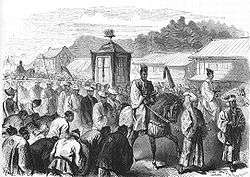Fall of Edo
The Fall of Edo (Japanese: 江戸開城, Hepburn: Edo Kaijō), also known as Edojō Akewatashi (江戸城明け渡し) and Edo Muketsu Kaijō (江戸無血開城), took place in May and July 1868, when the Japanese capital of Edo (modern Tokyo), controlled by the Tokugawa shogunate, fell to forces favorable to the restoration of Emperor Meiji during the Boshin War.
Saigō Takamori, leading the victorious imperial forces north and east through Japan, had won the Battle of Kōshū-Katsunuma in the approaches to the capital. He was eventually able to surround Edo in May 1868.[1]
Katsu Kaishū, the shōgun's Army Minister, negotiated the surrender, which was unconditional.[2]

Some groups continued to resist after this formal surrender but were defeated in the Battle of Ueno in northeastern Tokyo, on 4 July 1868. The city was fully under control in July 1868.[2] During that time, Tokugawa Yoshinobu had been under voluntary confinement at Kan'ei-ji temple.
On 3 September 1868, the city was renamed Tokyo ("Eastern capital"), and the Meiji Emperor moved his capital to Tokyo, electing residence in Edo Castle, today's Imperial Palace.[2]
A small monument has been erected at the location of the surrender meeting between Saigō Takamori and Katsu Kaishū, at Minato-ku, Shiba 5-33-1.
Cultural depictions
The Fall of Edo was depicted in various films and television series:
- Film
- Edojō Sōzeme (1930, dir. Seika Shiba)
- Edo Saigo no Hi (1941, dir. Hiroshi Inagaki)
- Dai Tokyo Tanjō Ōedo no Kane (1958, dir. Tatsuyasu Ōsone)
- Television drama
- Taiga drama
- Other
- Ōoku (2003)
Notes
- Kornicki, Peter F. (1998). Meiji Japan, p. 96.
- Perkins, Dorothy. (1997). Japan Goes to War, p. 8., p. 8, at Google Books; Marius Jansen. (1995). The making of modern Japan, p. 342., p. 342, at Google Books
References
- Jansen, Marius B. (2000). The Making of Modern Japan. Cambridge: Harvard University Press. ISBN 9780674003347; OCLC 44090600
- Kornicki, Peter. (1998). Meiji Japan: Political, Economic and Social History, 1868–1912. London: Routledge. ISBN 9780415156189; ISBN 9780415156196; ISBN 9780415156202; ISBN 9780415156219; ISBN 9780415156226; OCLC 470242993
- Perkins, Dorothy. (1997). Japan Goes to War: a Chronology of Japanese Military Expansion from the Meiji Era to the Attack on Pearl Harbor (1868–1941). Upland, Pennsylvania: Diane. OCLC 638765414
